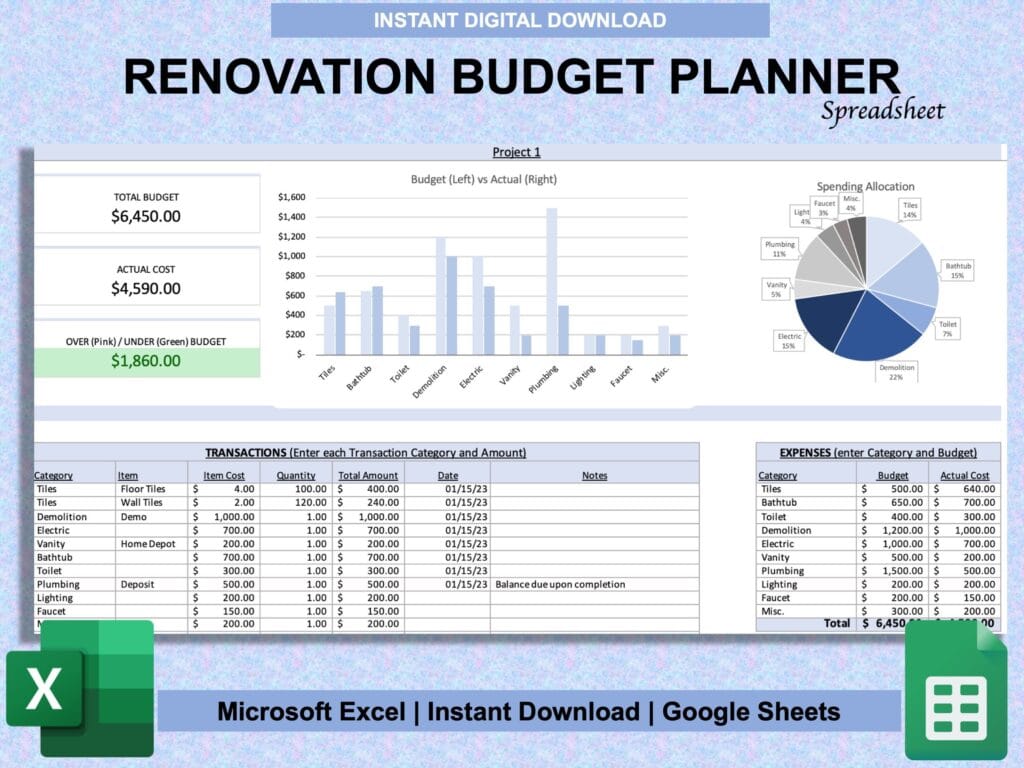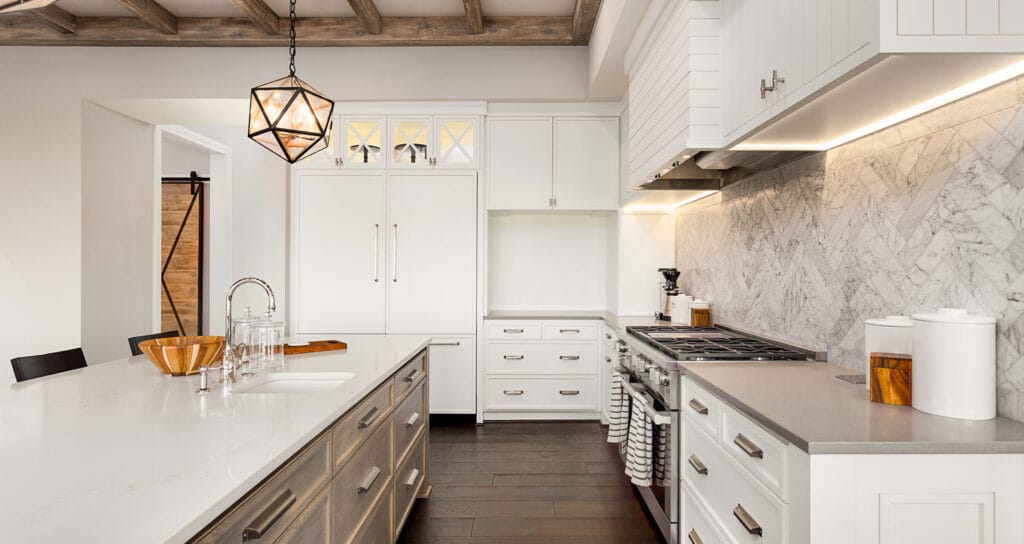What is a Home Renovation Cost? Home renovation cost refers to the total financial outlay required to modify, update, or improve an existing residential property. This encompasses a wide range of expenses, from materials and labor to permits and unexpected issues. Understanding these costs is crucial for effective budget planning and avoiding financial surprises. This guide will break down the key factors that influence home renovation expenses, helping you navigate your project with greater clarity and control.
Key Factors Influencing Home Renovation Costs
Home renovation costs are rarely straightforward; they are influenced by a multitude of interconnected factors. Recognizing these elements early in your planning process can help you set a realistic budget and make informed decisions. Here are the primary factors that will dictate how much you spend:
1. Scope of Work: The Breadth and Depth of Your Project
What is it? The scope of work defines the extent and nature of your renovation project. It outlines precisely what changes will be made, which areas of the home will be affected, and the level of transformation desired. A minor cosmetic update will naturally cost significantly less than a major structural overhaul or a complete home addition.
How it Affects Cost: The broader and deeper the scope, the higher the cost. This factor is perhaps the most significant determinant of your overall budget. Consider these aspects of scope:
•Size of the Project: Are you renovating a single bathroom, a kitchen, or an entire house? Larger areas or multiple rooms will require more materials, labor, and time, directly increasing expenses.
•Type of Renovation: Cosmetic changes (painting, new fixtures) are less expensive than functional upgrades (plumbing, electrical) or structural modifications (moving walls, adding square footage). Structural changes often require engineering assessments, permits, and specialized labor, adding considerable cost and complexity.
•Level of Finish: Are you aiming for a basic, mid-range, or luxury finish? High-end materials, custom cabinetry, and designer fixtures come with a premium price tag. The quality and uniqueness of finishes can dramatically inflate your budget.
•Demolition Required: Extensive demolition to reconfigure layouts or remove old structures adds to labor costs and disposal fees. Unexpected issues uncovered during demolition (e.g., mold, asbestos, outdated wiring) can further escalate expenses.

A visual representation of a renovation budget planner, highlighting various cost categories.
2. Material Choices: Quality, Availability, and Origin
What is it? Materials refer to all the physical components used in your renovation, from flooring and countertops to paint and plumbing fixtures. The selection of these materials plays a pivotal role in determining the final cost.
How it Affects Cost: Material costs can vary wildly based on several attributes:
•Quality and Durability: Premium materials (e.g., natural stone countertops, hardwood flooring, high-end appliances) are more expensive upfront but often offer superior durability, aesthetics, and longevity. Budget-friendly alternatives might save money initially but could require more frequent replacement or lack the desired finish.
•Brand and Design: Well-known brands and custom-designed elements typically command higher prices. Unique or imported materials can also be more costly due to shipping, tariffs, and limited availability.
•Availability and Lead Times: Supply chain issues or the need for custom-ordered materials can lead to delays and increased costs. Readily available, standard materials are generally more economical and quicker to acquire.
•Sustainability and Eco-Friendliness: While often a worthwhile investment, sustainable or eco-friendly materials (e.g., reclaimed wood, recycled glass countertops) can sometimes be more expensive than conventional options, depending on their sourcing and manufacturing processes.
3. Labor Costs: The Expertise Behind the Work
What is it? Labor costs represent the fees paid to contractors, subcontractors, and skilled tradespeople (e.g., plumbers, electricians, carpenters) who execute the renovation work. This is often one of the largest components of a renovation budget.
How it Affects Cost: Labor costs are influenced by:
•Skill and Experience: Highly experienced and reputable contractors or specialized tradespeople typically charge more for their expertise, but their work often results in higher quality, efficiency, and fewer mistakes.
•Location: Labor rates can vary significantly by geographic region, reflecting local cost of living and demand for skilled workers. Urban areas generally have higher labor costs than rural ones.
•Project Complexity: More intricate or specialized tasks (e.g., custom tile work, complex electrical rewiring, structural engineering) require more skilled labor and thus higher rates.
•Permits and Inspections: Many renovations require permits from local authorities to ensure compliance with building codes. The cost of permits and the time involved in inspections contribute to the overall labor and project timeline.
4. Unexpected Costs and Contingency Planning
What is it? Unexpected costs are unforeseen expenses that arise during a renovation project, often due to hidden issues discovered once demolition begins or changes made during construction. Contingency planning involves setting aside a portion of your budget specifically for these unforeseen circumstances.
How it Affects Cost: These costs can derail a budget if not anticipated:
•Hidden Damage: Issues like mold, water damage, pest infestations, or outdated plumbing/electrical systems are often only discovered once walls are opened up. Addressing these problems can be costly and time-consuming.
•Structural Surprises: Discovering unforeseen structural issues (e.g., rotting wood, foundation problems) can lead to significant additional expenses and require specialized contractors.
•Design Changes: Making changes to the design or materials after construction has begun can incur change order fees, additional material costs, and labor charges for rework.
•Permit Delays: Unforeseen delays in obtaining permits or passing inspections can extend the project timeline, leading to increased labor costs and potentially temporary housing expenses.

An illustration depicting various unexpected costs that can arise during a home renovation.
5. Location and Property Specifics
What is it? The geographical location of your property and its unique characteristics can significantly impact renovation costs. This includes factors beyond your control but crucial for budgeting.
How it Affects Cost:
•Geographic Location: As mentioned with labor, material and transportation costs also vary by region. Renovating in a high-cost-of-living area will generally be more expensive than in a lower-cost area.
•Age and Condition of Home: Older homes may require more extensive upgrades to meet current building codes or to address aging infrastructure (e.g., knob-and-tube wiring, galvanized pipes). Homes in poor condition will naturally demand more repairs before aesthetic changes can begin.
•Accessibility of the Site: If your property is difficult to access for deliveries or large equipment, it can increase labor time and transportation costs. Urban homes with limited street parking or narrow access points might incur higher logistical expenses.
•Local Regulations and Permits: Different municipalities have varying building codes, zoning laws, and permit requirements. These can add complexity, time, and cost to your project, especially for structural changes or additions.
Differences: How Renovation Costs Differ from New Construction
While both involve building, renovation costs often present unique challenges and cost drivers compared to new construction:
•Unforeseen Conditions: Renovations frequently uncover hidden issues (e.g., asbestos, lead paint, structural deficiencies) that are not present in new builds. These surprises can significantly inflate budgets and timelines.
•Demolition and Disposal: Renovations often require extensive demolition of existing structures, which adds labor and disposal costs not typically associated with new construction.
•Matching Existing Structures: Integrating new elements seamlessly with existing structures can be complex and costly, especially when trying to match older architectural styles or materials.
•Working Around Existing Systems: Renovators must often work around existing plumbing, electrical, and HVAC systems, which can be more challenging and time-consuming than installing new systems from scratch.
•Permit Complexity: While new construction also requires permits, renovation permits can sometimes be more complex due to the need to ensure new work complies with current codes while integrating with older, non-conforming elements.
Advantages of Understanding Renovation Costs
Having a clear grasp of the factors affecting home renovation costs offers several significant advantages:
•Realistic Budgeting: It enables you to create a more accurate and realistic budget, minimizing the risk of running out of funds mid-project.
•Informed Decision-Making: Understanding cost drivers empowers you to make smarter choices about materials, scope, and contractors, optimizing your investment.
•Reduced Stress: Financial surprises are a major source of stress during renovations. A well-understood budget reduces anxiety and allows for a smoother project experience.
•Better Negotiation: Knowledge of typical costs and influencing factors puts you in a stronger position to negotiate with contractors and suppliers.
•Increased Home Value: By strategically allocating your budget, you can focus on renovations that offer the best return on investment, ultimately increasing your home’s value.
Frequently Asked Questions (FAQ) about Home Renovation Costs
How much should I budget for unexpected renovation costs?
It is highly recommended to allocate a contingency fund of 10-20% of your total renovation budget for unexpected issues. For older homes or more extensive renovations, a higher percentage (e.g., 20-25%) is advisable.
Is it cheaper to renovate or to buy a new home?
This depends on many factors, including the extent of the renovation, the local real estate market, and your personal preferences. Renovating can be cheaper if your current home’s structure is sound and you only need cosmetic or minor functional upgrades. However, extensive renovations can sometimes approach or exceed the cost of a new build.
How can I save money on my home renovation?
Ways to save include doing some DIY work (if skilled), choosing more affordable materials, getting multiple quotes from contractors, being flexible with your timeline, and focusing on renovations that offer the best return on investment.
Do I need permits for my renovation?
Most structural changes, electrical work, plumbing, and additions require permits. Cosmetic changes like painting or replacing fixtures typically do not. Always check with your local municipality before starting any work to ensure compliance.
How do I find a reliable contractor?
Seek recommendations from friends and family, check online reviews, verify licenses and insurance, and get at least three detailed bids. Ensure they provide a clear contract outlining the scope of work, timeline, and payment schedule.
What is the average cost per square foot for a home renovation?
This varies significantly by location, type of renovation, and quality of materials. A general range might be $10-$60 per square foot for minor updates, and $100-$250+ per square foot for major remodels or additions. These are very broad estimates.
How long does a typical home renovation take?
The timeline depends heavily on the scope of work. A bathroom remodel might take 3-4 weeks, while a full kitchen renovation could take 6-10 weeks. Whole-house renovations can span several months to over a year.
Should I live in my home during a renovation?
For minor renovations, staying might be feasible. For major projects, especially kitchen or bathroom remodels, it can be disruptive and uncomfortable. Consider temporary relocation to avoid stress and ensure contractor efficiency.
What is the return on investment (ROI) for common renovations?
ROI varies, but typically, minor kitchen remodels, bathroom remodels, and exterior improvements (e.g., new siding, garage door replacement) offer good returns. Luxury upgrades often have a lower ROI.
How do material supply chain issues affect renovation costs?
Supply chain disruptions can lead to increased material costs due to scarcity, longer lead times, and higher shipping expenses. This can cause project delays and budget overruns.
What is the difference between a remodel and a renovation?
A renovation typically involves restoring something to a good state of repair, often with cosmetic updates. A remodel involves changing the structure or form of something, often altering the layout or function of a space. Remodels are generally more expensive.
How can XLISE help me with my renovation budget?
XLISE provides extensive resources, including detailed articles on budgeting strategies, cost breakdowns for various projects, tips for saving money, and guides on selecting materials and contractors. Our aim is to empower you with the knowledge to manage your renovation costs effectively and achieve your home improvement goals.





